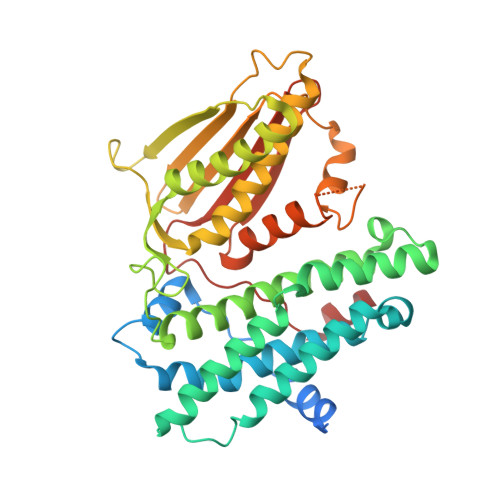Structural basis for the inhibition of PDK2 by novel ATP- and lipoyl-binding site targeting compounds.
Kang, J., Pagire, H.S., Kang, D., Song, Y.H., Lee, I.K., Lee, K.T., Park, C.J., Ahn, J.H., Kim, J.(2020) Biochem Biophys Res Commun 527: 778-784
- PubMed: 32444142
- DOI: https://doi.org/10.1016/j.bbrc.2020.04.102
- Primary Citation of Related Structures:
6LIL, 6LIN, 6LIO - PubMed Abstract:
Pyruvate dehydrogenase kinase (PDK) controls the activity of pyruvate decarboxylase complex (PDC) by phosphorylating key serine residues on the E1 subunit, which leads to a decreased oxidative phosphorylation in mitochondria. Inhibition of PDK activity by natural/synthetic compounds has been shown to reverse the Warburg effect, a characteristic metabolism in cancer cells. PDK-PDC axis also has been associated with diabetes and heart disease. Therefore, regulation of PDK activity has been considered as a promising strategy to treat related diseases. Here we present the X-ray crystal structure of PDK2 complexed with a recently identified PDK4 inhibitor, compound 8c, which has been predicted to bind at the lipoyl-binding site and interrupt intermolecular interactions with the E2-E3bp subunits of PDC. The co-crystal structure confirmed the specific binding location of compound 8c and revealed the remote conformational change in the ATP-binding pocket. In addition, two novel 4,5-diarylisoxazole derivatives, GM10030 and GM67520, were synthesized and used for structural studies, which target the ATP-binding site of PDK2. These compounds bind to PDK2 with a sub-100nM affinity as determined by isothermal titration calorimetry experiments. Notably, the crystal structure of the PDK2-GM10030 complex displays unprecedented asymmetric conformation of human PDK2 dimer, especially in the ATP-lids and C-terminal tails.
Organizational Affiliation:
Department of Chemistry, Gwangju Institute of Science and Technology, Gwangju, 61005, Republic of Korea.

















